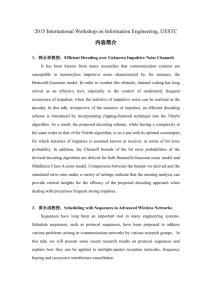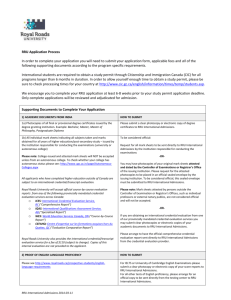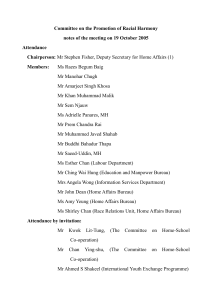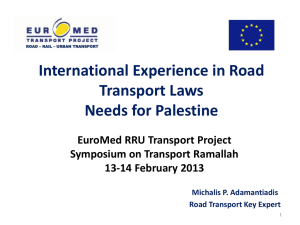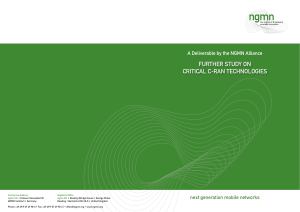*** 1
advertisement
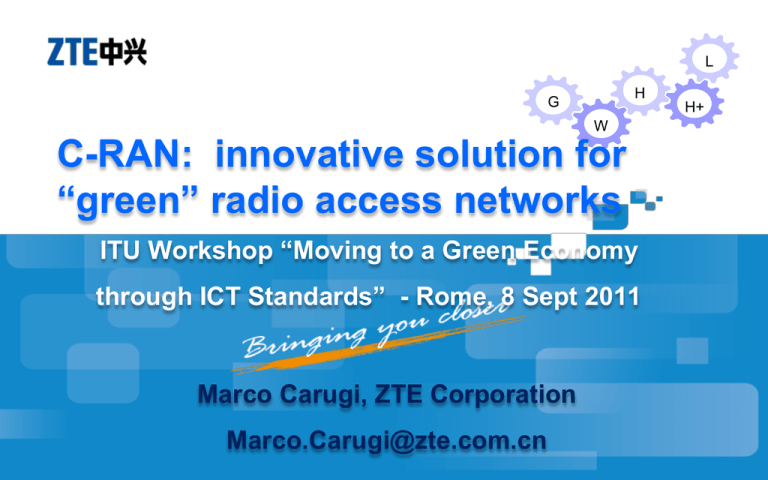
L H G H+ W C-RAN: innovative solution for “green” radio access networks ITU Workshop “Moving to a Green Economy through ICT Standards” - Rome, 8 Sept 2011 Marco Carugi, ZTE Corporation Marco.Carugi@zte.com.cn C-RAN and its benefits, including from a green perspective Highlights and case studies of ZTE CRAN L H G H+ What is C-RAN ? W Centralized Baseband Pool Cooperative Radio Cloud Computing Architecture Clean Network Innovative C-RAN Architecture Real-time Cloud for Centralized Processing Virtual BS Pool … Virtual BS Pool … X2+ PHY/MAC PHY/MAC PHY/MAC Optical Transport Network C High Bandwidth RAN Optical Transport Network RRU RRU RRU Cooperative Multi Point Processing RRU RRU Clean Network PHY/MAC RRU Distributed and Cooperative RRUs 4 RRU L Benefits of C-RAN H G H+ W Save Energy Consumption, Reduce Cell Interference, Reduce CO2 Emission Improve User Experience Optimize CAPEX and OPEX Concise Network Topology Match Tidal Traffic Migration Smooth Evolution Challenges of Wireless Network Development Rising Cost of Power Consumption due to Rapid Increasing Number of Base Stations Difficult Site Acquisition Results in Worse Network Quality and User Experience BS Number (10,000) Power consumption (100 million kwh) BS number Power Consumption Evolution of Convergent Multi-mode Network Traffic Volume Low Utilization Rate due to Limited Sharing of Base Station Resources Business Areas Residential Areas GSM GPRS EDGE eEDGE TDSCDMA WCDMA R99 HSPA+ HSPA TDD MBMS HSDPA R5 HSUPA R6 HSPA+ R7 MBMS cdma 1X cdma 2000 cdma 2000 EV-DO LT E 4G FDD EV-DO Rev. A EV-DO Rev. B Time 802.16 d Source: Statistic Data from a Chinese Operator 2010 6 802.16 e 802.16 m C-RAN Reduces 68% Power Consumption Scenario : China Mobile typical site model, total power consumption of traditional macro BS is 100% RAN Energy Consumption Breakdown Base Station Airconditioner Others (MW, Lights etc) Total Traditional Macro Base Station 48% 46% 6% 100% Distributed Base Station 24% 32% 5% 61% 39% 20.4% 9.6% 2% 32% 68% C-RAN Architecture Notes: Energy saving data may vary with regions and site models Traditional Macro Base Station Distributed Base Station 68% Energy Saving C-RAN Architecture 0% 20% Base Station 40% 60% 80% Air-conditioner 100% Others 7 120% Energy Saving (%) How to Reduce the Network TCO Effectively ? Data Source from China Mobile 7 Years Network TCO Analysis Site CAPEX Analysis Network Planning Site 6% Survey 6% OPEX Power CAF 24% Maintenan ce 21% CAPEX 60% TCO Maintenance Transmission Site Rental 31% Site Survey &NP CAF Site rental Site OPEX Analysis Civil work RAN equipment 40% TCO BTS 35% Civil Work 16% Transmis sion 13% Power Bill 41% Leased Line 7% Civil work, CAF, Site Rental and Site Maintenance take over 45% of Site TCO! 8 C-RAN Reduces 23% CAPEX and 70% OPEX Assumption: 180,000 new Sites, 350,000 CS, Typical site model of CMCC, 90% Sites have fiber resource Item (Thousand) Legacy Mode C-RAN Saving Ratio Equipment Cost Site Infrastructure Cost Transmission Cost Power Supply Cost Fiber Cost 3,780,000 3,402,000 684,000 1,116,000 3,942,000 3,060,000 1,240,200 144,000 651,600 3,942,000 19% 64% 79% 42% 0% Antenna and Feeder Cost 3,888,000 3,888,000 0% 16,812,000 12,925,800 23% Total (Thousand) C-RAN Mode Saves 23% CAPEX in total, around 3.89billion RMB 1.05 Billion Legacy Mode 0.32 Billion C-RAN C-RAN Mode Saves 70% OPEX per year, around 0.73Billion RMB 9 C-RAN Reduces Site Rooms by 10 Times MME xGW HSS HSS MME PCRF S S1 1 IP Backbone S1 C-RAN S1 IP Backbone S1 S1 xGW PCRF S1 Traditional : C-RAN S1 S1 C-RAN Architecture C-RAN : + Equipment Room at each Site + Air Conditioner, Transmission + Difficult for Site Acquisition + Long Site Construction Period + Complex Transmission routes - Only Equipment Rooms for BBU Hotel - No Air Conditioner and Transmission at Site - Easy Site Acquisition - Less Civil Work, Fast Deployment - Simplified and Flat Transmission Topology 10 C-RAN Reduces Operation Cost Dramatically X2 X2 O&M O&M C-RAN X2 IP Backbone IP Backbone X2 X2 C-RAN X2 X2 X2 X2 X2 Traditional + Hard to Manage and Monitor lots of distributed sites + High Site Visit and Maintenance cost + High Power Consumption and Room Rental Cost C-RAN Centralized site Management and Monitoring Only BBU hotel Visit and Maintenance Improved Operating Efficiency Low Energy Dissipation and low Rental Cost for each RRU site 11 C-RAN Turns Interference into Signal CoMP improves: Cell coverage Cell edge link quality and throughput System throughput and spectral efficiency Serving eNB Coordinated eNB UE1 Speed of Cell selection UE2 X2 Interface 12 CoMP Brings obvious Spectrum Efficiency Improvement LTE-A COMP Simulation Average Cell Spectrum Efficiency Improves 8.90% 112% 108.90% 108% Cell Edge Spectrum Efficiency Improves 31.20% 160% 131.20% 120% 105.30% 117.80% 100% 104% 100% 80% 100% 40% 96% 92% 0% Single Cell Intra Site JP High TX Power JP Single Cell Intra Site JP High TX Power JP Source:ZTE Down Link Joint Processing Simulation in Homogeneous network 13 C-RAN Applies 4G Technology to 2G Networks RRU RRU Independent Physical Cell Share Logical Cell RRU RRU Hand Over Hand Over RRU RRU RRU RRU Cooperative Cooperative RRU RRU No Inter-Cell Interference Diversity Gain RRU BBU RRU RRU Interference in overlap area RRU No Diversity Gain BBU Option 1: Baseband Combination Option 2: RF Combination 14 L Highlights and case studies of ZTE C-RAN H G H+ W ZTE C-RAN DRA Strategy Demand Baseband Sharing Requirements Architecture BBU One BBU support 108CS (GSM/TD-S) BBU support dynamic resource allocation B8200 Multi-RRU share logical cell Cooperative Radio B8300 18 Levels RRU Daisy Chain High Efficient IQ Bearing Redundancy and Reliability RRU 6Gbps/10Gbps Fiber Interface Single RRU support 12TRX BBU Redundancy Design RRU support ring topology 16 R8860 R8882 R8968/8928 C-RAN Case Study - China Unicom Dalian Executive summary: in Dalian, with Baseband Pool Solution, 568 BBUs are centralized and located in 53 central offices, 2337 RRUs are connected to these BBUs C-RAN No.1 800 600 757 ZhongShan center office Saving of 704 equipment rooms, about 93% BBU: 102, RRU: 365 400 200 C-RAN No.2 XiGang center office 53 0 BBU: 72, RRU: 189 C-RAN network construction mode saved 9.398 million RMB for China Unicom Innovation C-RAN construction reduced more than 80% power consumption. 17 BBU cabinet 11 BBUs in one cabinet C-RAN Dalian Optimizes Performance in 3D Coverage Scenario Main Street Coverage, 30° down tilt Indoor Coverage BBU Cover age of opposite buildings, +45°up tilt RRU Street Coverage, Low Ant RRU RRU Road Coverage RRU Cover age of opposite buildings by wide horizontal beam, Horizontal antenna Multiple RRUs combine into one super logical cell Baseband sharing solves the indoor and outdoor cooperative problem 18 C-RAN Case Study - China Mobile ZhuHai Tangjia Ring S444 S444 S444 S444 S444 S444 S444 S444 S444 Jinding Ring S444 S444 S444 District overview: About 30km2 ,18 sites (9 new sites, 9 co- located with existing GSM sites) District feature: Uptown, high-tech part and college park, high data traffic, obvious Tidal Traffic Effect Site feature: Selected sites are near to the access fiber ring, few excavation and pipeline deployment work 19 S444 S444 S444 S444 S444 S444 CM ZhuHai: Baseband pool reduces 50% BP Resource At Night Traffic migration Daytime Business district/Campus area 27 carriers static 27 carriers static Super baseband pool and dynamic resource allocation can effectively reduce BP hardware resource, and enhance the disaster tolerance capability of RAN Residential area 54 carriers dynamic Mode BBU Number BP Board Number BP loading Backup Distributed 9 18 75% 1:1 C-RAN 2 9 < 75% 7:2 20 Embrace C-RAN, Keep Away from Nuclear Pollution Billion KWh China Mobile 2010 Energy Consumption and Analysis Annual CO2 emissions of 600 thousands cars 16 RAN Others 12 3.30 8 4 3.30 8.76 = = 5.83 0 100% Traditional 50% USE C-RAN If 50% of network uses C-RAN solution, China Mobile can save 2.93 billion KWh per year Nuclear Energy C-RAN 21 The annual energy output of Fukushima nuclear power plant group one L H G H+ W Thanks for your attention ITU Workshop “Moving to a Green Economy through ICT Standards” - Rome, 8 Sept 2011 L H G H+ W Backup slides ITU Workshop “Moving to a Green Economy through ICT Standards” - Rome, 8 Sept 2011 C-RAN Solves the Problem of Tidal Traffic Migration Traffic Migration Downtown Uptown Dynamic Sharing Carrier Resource Sharing M Carriers Dynamic TRX allocation allocation threshold according traffic migration Pre-Set Allocation N Carriers Save xx carrier-sector baseband resources 24 Adjustable Baseband resource Adjustable Baseband resource release threshold Cooperative Radio Basic Concept of Cooperative Radio: Multiple nodes serve one terminal through cooperation, with the highest overall network efficiency Collaborative radio is a mandatory technology of LTE-A Collaborative radio is the basic of Mesh Networks and Cognitive Radio Comparison between Traditional Network and Cooperative Radio Carrier Needs in the Future Technical Needs In the Future Traditional Network Mode Cooperative Radio Mode Abundant Spectrum Higher Frequency band, Higher Bandwidth High Power Transmission Low Power Transmission Over100Mbps throughput High order Modulation, Micro Cell Dramatically degrade in celledge speed Obviously Improve in celledge speed Seamless Coverage in both outdoor and indoor High density, cooperative between indoor and outdoor More sites, distributed Less sites, centralized Smooth Evolution from 2G to 3G/4G Multi-mode co-existence Difficult for inter-RAT resource sharing Possible for inter-RAT resource sharing 25 Multi-Mode C-RAN Network Evolution GSM BTS IP/SDH Backbone GSM GSM BSC GSM EMS TD-SCDMA IP/SDH Backbone TD RNC TD RRU TD BBU TD EMS NetNumen Unified OAM Converged G/T/L C-RAN Network GSM/TD/LTE Unified EMS G T S D M S iBSC/TD RNC Dual Mode controller IP/SDH Backbone G/T/L Multi-Mode BBU Dynamic Sharing Pool G/T/L RRU T/L RRU GSM RRU T/L RRU FDD/TDD Shared IQ Fiber GSM RRU
